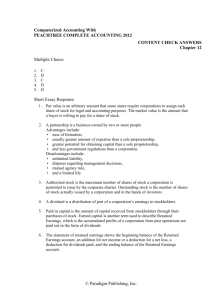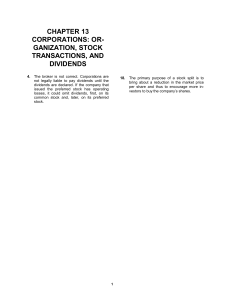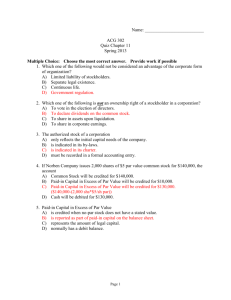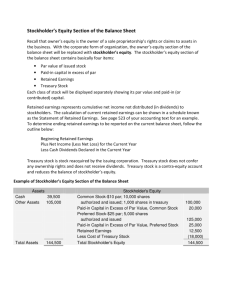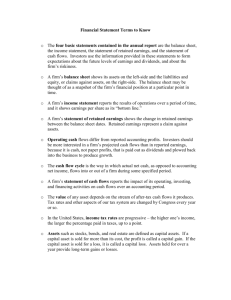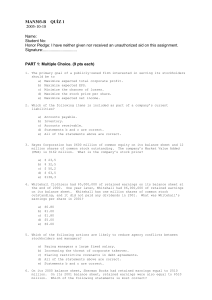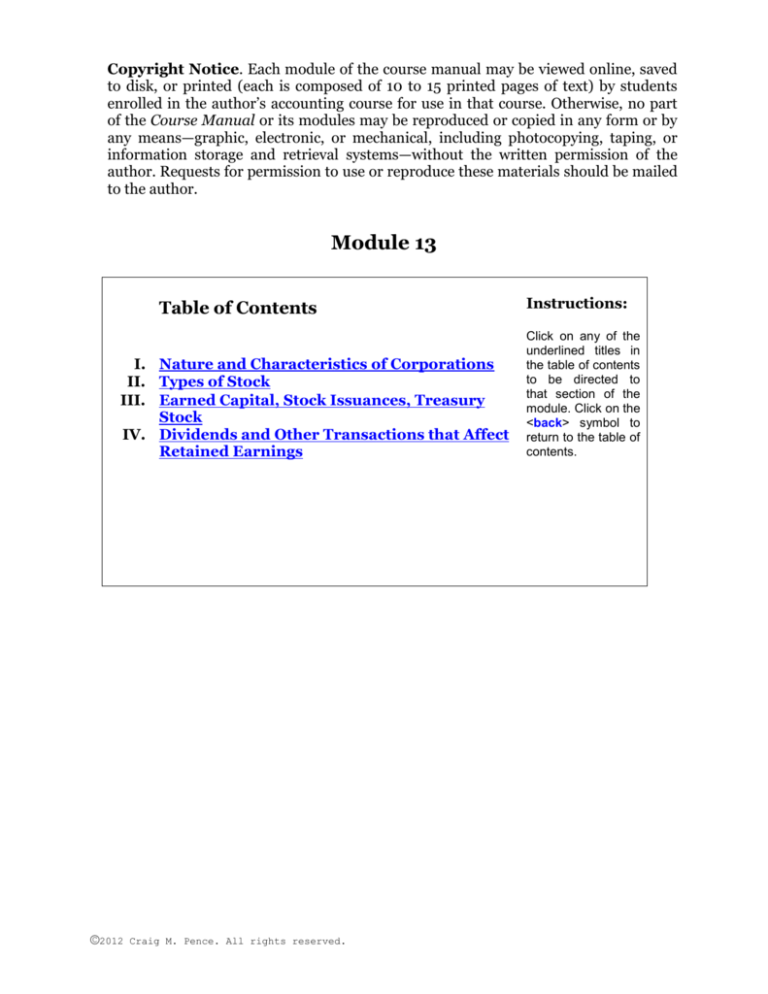
Copyright Notice. Each module of the course manual may be viewed online, saved
to disk, or printed (each is composed of 10 to 15 printed pages of text) by students
enrolled in the author’s accounting course for use in that course. Otherwise, no part
of the Course Manual or its modules may be reproduced or copied in any form or by
any means—graphic, electronic, or mechanical, including photocopying, taping, or
information storage and retrieval systems—without the written permission of the
author. Requests for permission to use or reproduce these materials should be mailed
to the author.
Module 13
Table of Contents
I. Nature and Characteristics of Corporations
II. Types of Stock
III. Earned Capital, Stock Issuances, Treasury
Stock
IV. Dividends and Other Transactions that Affect
Retained Earnings
©2012
Craig M. Pence. All rights reserved.
Instructions:
Click on any of the
underlined titles in
the table of contents
to be directed to
that section of the
module. Click on the
<back> symbol to
return to the table of
contents.
2
Accounting Course Manual
Module 13 Summary
I.
Nature and Characteristics of Corporations
A.
Our discussions to date have dealt with sole proprietorships, the most
numerous type of business in America today. However, large businesses
are almost always organized as corporations, and it is corporations that
generate more business sales volume than any other type of business.
Corporations have status as an "artificial being," or separate legal
entity in the eyes of the law. This creates major differences between
corporations and the other legal forms of business organization (sole
proprietorships and partnerships).
B.
Organization of Corporations
1.
The corporation is started when the articles of incorporation
are filed with the state and the corporate charter is received.
The charter lists the business purpose, organizational structure,
types of stock that may be issued, and the number of shares of
stock that may be issued (called the authorized shares).
2.
The stockholders write the corporation bylaws and elect the
board of directors after the charter is received.
a.
The Board is responsible for major policy decisions;
individual stockholders can only influence the board through
their votes at the annual meeting.
b.
The Board “declares” dividends (determines the amount
and the payment dates)
c.
The Board hires the corporate officers: The President (or
CEO), Vice-Presidents of Finance, Production, Personnel,
etc.; the Secretary; Treasurer and Controller.
<back>
II.
Types of Stocks and their Characteristics
A.
Ownership equity in corporations is represented by shares of
corporation stock, certificates that represent legal ownership of a
portion of the company.
B.
The corporation issues stock to raise needed financing (capital).
This is done through a group of banks and stockbrokers, called the
underwriters, who help the company place its stock issue with
investors. A company's very first issuance of stock is called its initial
public offering or IPO.
©2012 Craig M. Pence. All rights reserved.
Accounting Course Manual
3
C.
When the articles of incorporation are approved by the state, the
corporation will be authorized to issue up to a certain number of
shares of stock. This maximum number is referred to as the
authorized shares.
D.
Stock that has been sold to stockholders is called issued stock. If
the corporation purchases some of its own stock from stockholders
(called treasury stock) these shares are still considered to be
issued shares, but they are no longer outstanding shares. A
corporation that has not issued all the shares it has been authorized
and that has also purchased some treasury shares, would report a
large number of shares as authorized, a smaller number of shares
as issued, and a slightly smaller number as outstanding.
E
Stocks may or may not have a par value, depending on the laws in
the state of incorporation.
1.
In some states par value establishes legal capital (the
amount of shareholder contributions that by law cannot be
paid back to shareholders as dividends in order to protect
creditors from losses).
2.
Other states, such as Illinois, define legal capital as anything
paid in by shareholders, irregardless of any par value. Since
it is irrelevant in establishing legal capital in these cases,
some of these states allow or require the issuance of no-par
stock.
3.
Stock may have a stated value instead of par. Stated value
stock is accounted for in the same way as par value stock.
Click the link below to play an audio presentation that discusses the concept
of “legal capital.”
Link to “Legal Capital” Presentation
F.
There are two general types of stock, common stock and
preferred stock. They both represent owners' equity in the
corporation, but they differ in regard to the legal rights the
stockholders have regarding dividends, voting at the annual
meeting, and so on.
1.
Common stockholders have several general legal rights:
a.
Right to receive a proportionate share of any
dividends distributed to the common stockholders (all
common stockholders will receive an equal amount
per share held).
©2012 Craig M. Pence. All rights reserved.
4
Accounting Course Manual
b.
2.
3.
Right to maintain their percentage ownership of the
corporation's stock by being offered that same
percentage of any new issue of stock before it can be
sold to anyone else (called the preemptive right).
c.
Right to receive a proportionate share of the final
liquidating dividends in the event of the failure of the
business.
d.
Right to vote for directors and on other important
policy issues.
Common stock may be issued in different classes (e.g., class
A, class B, etc.), in which case rights may be limited for some
classes of stock.
Preferred stock is another type of stock. It is called
“preferred” because it guarantees its holders legal
preference over common stockholders in regard to normal
dividends from earnings as well as final liquidating
dividends. Preference is a legal term which means that
preferred shareholders receive all of the dividends due to
them before anything can be paid to common stockholders.
a.
In order to determine what amount should be paid to
preferred stockholders, the normal dividend for the
year is usually stated as a percentage of par value
(e.g., 5% preferred stock with a $100 par value would
pay $5 per share in dividends).
b.
Preferred stock generally does not have voting rights.
c.
Preferred is often cumulative (dividends not paid in
the past accumulate and must be paid in later years).
If it is, any dividends in arrears (an accumulation
from prior years) should be disclosed in the financial
statements or in a footnote. Like current year
dividends, they must be paid to preferred
stockholders before any dividends can be distributed
to common stockholders.
d.
Preferred may also be convertible (shareholders
may exchange their preferred shares for a preset
number of common shares).
e.
Preferred may also be callable (the corporation can
force shareholders to surrender their shares at a
preset price, called the call price). If called, the
preferred stockholder will receive the call price, any
dividends in arrears, and a proportionate share of the
current year's dividend.
f.
In liquidation, preferred stockholders are entitled to
the par value of their shares, or the call price if one
©2012 Craig M. Pence. All rights reserved.
Accounting Course Manual
5
exists. They are also entitled to any dividends that
might be in arrears.
<back>
III. Accounting for Earned Capital, Stock Issuances, and
Treasury Stock Transactions
A.
Owners' equity (called stockholders' equity) in corporations is divided
into two categories: paid-in capital (received as an investment
contribution from the stockholders) and earned capital (earnings that
have been retained in the business and not distributed to the
stockholders).
B.
Earned Capital and Retained Earnings. The account used to record
earned capital is the Retained Earnings account.
1.
When the Income Summary account is closed at the end of the
accounting period, the corporation’s net income is transferred from
Income Summary to the Retained Earnings account:
Income Summary
Retained Earnings
2.
3.
4.
5.
C.
$X
$X
Recall that the legal capital laws in Illinois prevent the corporation
from distributing paid-in capital to stockholders. Therefore, in
order to pay a dividend, there must be a balance in Retained
Earnings large enough to cover the dividend payment. Any balance
left in Retained Earnings represents earnings that have not been
paid out to stockholders in the form of dividends.
The balance in Retained Earnings represents net income that was
not distributed to the stockholders as dividends. It does not
represent cash reserves, since the cash may have been used for
other things or may still be tied up in receivables.
A debit balance in Retained Earnings (which could result from
losses) is called a deficit. It does not mean the corporation is
bankrupt, since cash may still be available to pay bills as they come
due.
Other acceptable titles for the Retained Earnings account are
Retained Income, Accumulated Earnings or Earnings Retained for
Use in the Business. The term Surplus is antiquated and should not
be used.
Paid-in Capital. When common or preferred stock is issued to
stockholders who have contributed assets to the corporation, an asset
account is always debited and paid-in capital accounts are credited.
©2012 Craig M. Pence. All rights reserved.
6
Accounting Course Manual
1.
The Common Stock or Preferred Stock account is credited for
the par value of the shares issued. Paid-In Capital in Excess of
Par Value is credited for any excess over par or stated value:
Asset (Cash, Equipment, etc.)
Common (or Preferred) Stock
Paid-in Capital in Excess of Par Value
2.
3.
4.
D.
$X
$X
If the stock has a stated value instead of a par value, Common
Stock is credited for the stated value of the shares issued, and a
Paid-in Capital in Excess of Stated Value account is used for
the excess over stated value, but otherwise the entry is the same.
If the stock is no-par stock, a Paid-in Capital in Excess account is
not used and the full amount is entered in the Common (or
Preferred) Stock account.
When stock is issued for assets other than cash, the new asset
should be recorded at its fair market value. If the market value of
the stock is known at the time of the exchange, it should be used to
value the new asset. If not, the estimated fair value of the asset may
be used instead.
Presentation of Paid-in Capital and Earned Capital Accounts
on the Balance Sheet. Paid-in capital accounts are separated from the
earned capital accounts when the stockholder’s equity section of the
balance sheet is prepared. The format is as follows:
Preferred Stock, $X par value, X shares authorized and issued
Paid-In Capital In Excess of Par Value – Preferred Stock
Common Stock, $X par value, X shares authorized and issued
Paid-In Capital In Excess of Par Value – Common Stock
Total Paid-In Capital
Retained Earnings
Total Stockholders’ Equity
E.
$X
$X
$X
$X
$X
$X
$X
$X
Treasury Stock (shares of the corporation's own stock that are
purchased in the open market by the corporation). Purchases of Treasury
Stock represent a distribution of cash to shareholders.
1.
The only other way distributions may occur is through the payment
of dividends.
2.
Like dividends, purchases of Treasury Stock represent a
distribution of earned capital and are restricted by legal capital
requirements.
©2012 Craig M. Pence. All rights reserved.
Accounting Course Manual
3.
4.
Treasury stock is considered to still be issued stock but is not
outstanding. It therefore does not receive dividends and cannot be
voted at stockholder meetings.
The entry to record treasury stock purchases requires a debit to
Treasury Stock and credit to Cash for the cost of the shares:
Treasury Stock
Cash
5.
6.
$X
$X
Treasury Stock
Paid-in Capital from Sale of Treasury Stock
$X
$X
Note that the reissuance of treasury stock "frees up" earned capital
so that it is now available for the payment of dividends; however,
amounts received in excess of cost are considered paid-in capital
(not available for dividends).
If treasury stock is reissued for less than original cost, the debit
difference between cash received and original cost goes to Paid-in
Capital from Sale of Treasury Stock:
Cash
Paid-in Capital from Sale of Treasury Stock
Treasury Stock
8.
$X
Treasury Stock is a "negative" stockholder equity account (i.e., a
stockholder equity account with a normal debit balance) which is
subtracted at the bottom of the stockholder equity section of the
balance sheet to determine total stockholder equity.
When treasury stock is reissued, Cash is debited for the amount
received, and Treasury Stock is credited for the original cost of the
shares. Amounts received in excess of cost are credited to a
contributed capital account, Paid-in Capital from Sale of
Treasury Stock:
Cash
7.
7
$X
$X
$X
If the balance in Paid-in Capital from Sale of Treasury Stock is not
sufficient to absorb all the debit difference, the remainder goes to
Retained Earnings. This is appropriate, since it is now clear that a
permanent distribution of assets to stockholders did indeed occur,
and such distributions are made from Retained Earnings (see the
next section, which focuses on earned capital transactions and the
Retained Earnings account).
©2012 Craig M. Pence. All rights reserved.
8
Accounting Course Manual
Cash
Paid-in Capital from Sale of Treasury Stock
Retained Earnings
Treasury Stock
9.
$X
$X
$X
$X
The stockholder’s equity section of the balance sheet, with treasury
stock accounts included, is as follows:
Preferred Stock, $X par value, X shares authorized and issued
Paid-In Capital In Excess of Par Value – Preferred Stock
Common Stock, $X par value, X shares authorized and issued
Paid-In Capital In Excess of Par Value – Common Stock
Paid-In Capital from Sale of Treasury Stock
Total Paid-In Capital
Retained Earnings
Deduct Treasury Stock (X shares at cost)
Total Stockholders’ Equity
$X
$X
$X
$X
$X
$X
(X)
$X
$X
$X
<back>
Here’s an Example!
Tops Corporation is authorized to issue 100,000 shares of $2 par value common stock and 10,000
shares of $100 5% preferred stock. Journalize the following transactions, then prepare the
corporation’s balance sheet.
a.
The corporation begins operations by issuing 5,000 shares of common stock, receiving $15,000:
Cash
15,000
Common Stock
10,000
Paid-In Capital in Excess of Par Value - CS
5,000
b. The corporation issues 80 shares of preferred stock, receiving $12,000:
Cash
Preferred Stock
Paid-In Capital in Excess of Par Value - PS
c.
12,000
8,000
4,000
The corporation issues 1,000 shares of common stock in exchange for a machine valued at
$3,000:
Machine
3,000
Common Stock
2,000
Paid-In Capital in Excess of Par Value - CS
1,000
Continued on following page
©2012 Craig M. Pence. All rights reserved.
Accounting Course Manual
9
Continued from previous page.
d. The corporation purchases 500 shares of its common stock to hold as treasury shares, paying $4
per share:
Treasury Stock
2,000
Cash
2,000
e.
f.
g.
The corporation reissues 100 shares of the treasury stock, receiving $5 per share:
Cash
500
Treasury Stock
Paid-In Capital from Sale of Treasury Stock
400
100
The corporation reissues 50 shares of the treasury stock, receiving $3 per share:
Cash
150
Paid-In Capital from Sale of Treasury Stock
50
Treasury Stock
200
The corporation completes the closing process, and transfers the $20,000 credit balance in
Income Summary into the Retained Earnings account.
Income Summary
20,000
Retained Earnings
20,000
h. Prepare the Stockholders’ Equity section of the corporate balance sheet.
Stockholders’ Equity
Preferred Stock, $100 par value, 10,000 shares authorized, 80 shares
issued and outstanding
Paid-In Capital In Excess of Par Value – Preferred Stock
Common Stock, $2 par value, 100,000 shares authorized, 6,000
issued, 5,650 outstanding
Paid-In Capital In Excess of Par Value – Common Stock
Paid-In Capital from Sale of Treasury Stock
Total Paid-In Capital
Retained Earnings
Deduct Treasury Stock (350 shares at $4 cost)
Total Stockholders’ Equity
$ 8,000
4,000
12,000
6,000
50
30,050
$20,000)
(1,400)
18,600
$48,650
Click the link below to play a video presentation that “walks you through”
the example above.
Link to “Stock Issuances and Treasury Stock” Presentation
©2012 Craig M. Pence. All rights reserved.
10
Accounting Course Manual
IV.
Transactions that Affect the Retained Earnings Account.
A.
Dividends represent distributions of the corporation's earned capital (its
income) to its shareholders. Therefore, the distribution of dividends
results in a decrease in assets and a decrease in the Retained Earnings
account balance.
1.
Dividends must be declared by the board of directors (this is
usually done quarterly).
2.
There are several important dates associated with dividends:
a.
Declaration date -- date dividends were announced by
board; at this point the dividend is a legal liability.
b.
Date of record -- date stockholders must be registered
owners (in corporation's records) in order to receive the
dividend.
c.
Payment date -- date dividends will be distributed.
d.
Ex-dividend date -- the date at which the buyer of the
stock is no longer entitled to the dividend.
B.
Under legal capital requirements a balance at least equal to the amount of
the dividend must exist in Retained Earnings and the other stockholders'
equity accounts that do not constitute legal capital before the dividend can
be declared. Of course, cash must also be available in order to make the
payment.
C.
Accounting for cash dividends:
1.
On the declaration date the dividends become legal liabilities
and must be recorded:
Cash Dividends
Dividends Payable
2.
$X
On the payment date cash is distributed and is recorded:
Dividends Payable
Cash
3.
$X
$X
$X
When the closing entries are made, the Cash Dividends
account is closed into Retained Earnings:
Retained Earnings
Cash Dividends
©2012 Craig M. Pence. All rights reserved.
$X
$X
Accounting Course Manual
4.
D.
The net effect of these entries is to reduce cash assets and to reduce
Retained Earnings by the amount of the dividends that were
distributed.
Investors are interested in the rate of return they earn on their
investments. The dividend yield ratio measures the percentage rate of
return an investor earns from the dividend he or she receives from their
stock investment. Dividend yields are usually rather meager, and are
sometimes zero because some companies pay no dividends at all.
Remember, though, that investors expect to sell their shares in the future
at a profit. This gain is also instrumental in determining the rate of return
the investor will earn on the stock investment.
Dividend Yield =
E.
11
Cash Dividend per Share
Market Price per Share
Accounting for Stock Dividends. In addition to cash dividends,
stock dividends (newly issued shares of stock that are distributed to
stockholders instead of cash) may be declared. They also decrease the
Retained Earnings account.
1.
Stock dividends do not result in a distribution of assets to
shareholders. They are therefore "costless" to the corporation and
"valueless" to shareholders.
2.
When stock dividends are declared, the Stock Dividends account
is debited for the market value of the shares that will be issued.
Since new shares will be distributed on the payment date instead of
cash, Common Stock Distributable is credited instead of
Dividends Payable. Since the balance in Common Stock represents
the par value of the shares that have been issued, that account
cannot be credited until the shares are issued on the payment date.
Therefore, the par value is "parked" temporarily in Common Stock
Distributable. This account is a paid-in capital account, not a
liability account. Paid-in Capital in Excess of Par Value is credited
for the excess of market value over par:
Retained Earnings
$X
Common Stock Distributable
Paid-in Capital in Excess of Par -- Common Stock
3.
$X
$X
On the distribution date, the stock is issued. This means the balance
in the Common Stock Distributable account can now be moved into
the Common Stock account:
©2012 Craig M. Pence. All rights reserved.
12
Accounting Course Manual
Common Stock Distributable
Common Stock
4.
$X
When the closing entries are made, the Stock Dividends account is
closed into Retained Earnings:
Retained Earnings
Stock Dividends
5.
$X
$X
$X
The net effect of these entries is to transfer earned capital (Retained
Earnings) into contributed capital accounts (Common Stock and
Paid-in Capital in Excess of Par Value).
Continuing the Example!
Tops Corporation’s stock issuance and treasury stock transactions were recorded in the previous
example. We will now illustrate transactions related to dividend declarations. Remember that Tops
Corporation has issued 6,000 shares of $2 par value common stock and 80 shares of $100 par
value 5% preferred stock. Also, the company holds 350 treasury shares. Journalize the following
transactions, then prepare the corporation’s balance sheet.
a.
The corporation declares the annual dividend on the preferred stock and a $.10 per share
dividend on the common stock:
Cash Dividends
965
Preferred Stock Dividends Payable
Common Stock Dividends Payable
Preferred dividends = 5% x $100 par = $5 x 80 shares = $400
Common dividends = $.10 x 5,650 shares = $565.
b. The corporation pays the dividends:
Preferred Stock Dividends Payable
Common Stock Dividends Payable
Cash
c.
400
565
965
The corporation declares a 10% stock dividend on the common stock:
Stock Dividends
1,695
Common Stock Distributable
Paid-In Capital in Excess of Par Value - CS
10% x 5,650 shares = 565 new shares x $3 market price = $1,695 market value.
565 new shares x $2 par value = $1,130 par value.
d. The corporation issues the stock dividend shares:
Common Stock Distributable
Common Stock
Continued on following page
©2012 Craig M. Pence. All rights reserved.
400
565
1,130
565
1,130
1,130
Accounting Course Manual
13
Continued from previous page.
e. The corporation closes the “Cash Dividends” and “Stock Dividends” accounts into the “Retained
Earnings” account:
Retained Earnings
2,660
Cash Dividends
965
Stock Dividends
1,695
h. Prepare the Stockholders’ Equity section of the corporate balance sheet.
Stockholders’ Equity
Preferred Stock, $100 par value, 10,000 shares authorized, 80 shares
issued and outstanding
Paid-In Capital In Excess of Par Value – Preferred Stock
Common Stock, $2 par value, 100,000 shares authorized, 6,565 issued,
6,215 outstanding
Paid-In Capital In Excess of Par Value – Common Stock
Paid-In Capital from Sale of Treasury Stock
Total Paid-In Capital
Retained Earnings
Deduct Treasury Stock (350 shares at cost)
Total Stockholders’ Equity
$ 8,000
4,000
13,130
6,565
50
31,745
17,340)
(1,400)
15,940
$47,685
Click the link below to play a video presentation that walks you through the
exampleabove.
Link to “Dividend Declaration” Presentation
F.
Stock Splits. When the stock is split the old shares are called in and
replaced with a greater number of new shares that carry a proportionately
lower par or stated value.
1.
For example, a 2-for-1 stock split means there will be twice as many
shares outstanding after the split, but the par value will be half of
what it used to be. Therefore, the total par value of the stock issued
does not change, and this means that the balance in Common Stock
does not change.
2.
Since the balance in the Common Stock account does not change
when the stock is split, a journal entry is not required to record the
split. However, the number of shares issued and outstanding and
the par (or stated) value do change, so these figures will be different
on the balance sheet. If Tops Corporation split its $2 par value stock
2-for-1, the balance sheet above would now report the following:
Common Stock, $1 par value, 100,000 shares authorized, 13,130
issued, 12,430 outstanding
©2012 Craig M. Pence. All rights reserved.
13,130
14
Accounting Course Manual
G.
Restrictions on Retained Earnings. Retained earnings may be
appropriated by the Board, which means that of the capital available for
payment as dividends a certain amount has been restricted for other
internal uses. Such restrictions must be disclosed, either through footnote
disclosure or on the face of the balance sheet. Note that the total earned
capital of the corporation is not reduced by restrictions, though the
corporation's ability to pay dividends has been diminished.
H.
Retained Earnings Statement. A statement of retained earnings is
similar to the statement of owner's equity that was prepared in earlier
modules for a sole proprietorship. The statement of retained earnings
merely presents the beginning balance in the Retained Earnings account,
and then lists the items that increased or decreased the account's balance
during the accounting period. The end result will be the ending balance in
the Retained Earnings account. For Tops Corporation, the statement will
appear as follows:
Tops Corporation
Retained Earnings Statement
Retained earnings, beginning balance
Net income
Less: Cash dividends
Stock dividends
Increase in retained earnings
Retained earnings, ending balance
I.
$0
$20,000
(965)
(1,695)
17,340
$17,340
Prior period adjustments result from errors made in prior periods.
Adjusting entries are necessary in the current period to correct the account
balances that are now wrong because of these past errors. Prior period
adjustments are not reported on the income statement. They are recorded
by making a journal entry directly to Retained Earnings and are reported
on the Retained Earnings Statement.
<back>
-END-
©2012 Craig M. Pence. All rights reserved.



